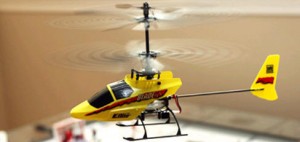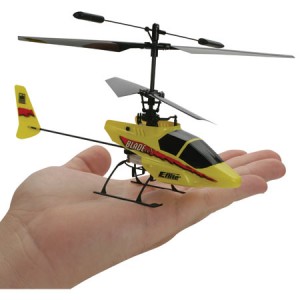E-flite Blade mCX Helicopter – Technology & Fun in a Box
It’s not often that a product exceeds expectations, both in terms of fun, ease of use, durability, design impressiveness, and overall value. But the E-flite mCX Ready To Fly (RTF), Ultra-Micro helicopter is just such a product – elegantly optimized for its intended purpose of entry-level indoor flight.
Not only is it a joy to learn to fly with this helicopter, but it is also fascinating from an engineering perspective based on its clever and effective integration of advanced technologies. For instance, the 4-channel transmitter employs spread spectrum technology which minimizes susceptibility to interference as well as minimizes interference to other potential nearby fliers. The dual counter-rotating blades eliminate adverse yaw arising from single blade designs and eliminate the need and complexity of a tail rotor. The onboard 5-in-1 Control Unit seamlessly computes the inputs to the dual motor system enabling full 3-dimensional motion. This is a terrific helicopter for those that want to spend more time flying than tinkering, however it is not designed for advanced aerobatics as some of the larger versions are. Extremely small, yet highly effective motors provide power to the dual blades and an innovative servo system provides motion inputs to the rotors. Combined with the advanced, small and lightweight Lithium Polymer batteries, the mCX is truly a noteworthy integration of technology.
Everything needed for a rewarding first flight is right in the box, which also serves as a highly functional case with room for additional batteries. Getting to the first flight is quick and easy:
Read the instructions, paying close attention to safety-related information. (Always make sure that the transmitter is turned on first and that the helo battery is disconnected before the transmitter is turned off).
Insert four AA batteries into the transmitter.
Charge the helicopter battery in the nicely designed charger which uses an additional 4 AA batteries to charge the helo batteries. Note that the charger does not need to be plugged into the wall – making recharging very convenient.

Turn on the transmitter.
Insert and connect a fully charged battery into the mCX.
Wait for the 5-in-1 control unit to initialize and arm (a few seconds)
You are ready to fly.
Upon applying throttle, the mCX’s stability immediately becomes clear when hovering. First practice some simple and gentle maneuvering then work your way up to more complex flight paths. The transmitter even has two available input control sensitivity settings. One for absolute beginners and the other offers a more responsive level of sensitivity for even more fun. Even on the more sensitive of the two, the mCX is very stable yet accommodates the beginner’s evolving skills.
Clearly, much design ingenuity is required for such a small, lightweight helo. Yet, one can immediately see that the mCX design is of very high quality. Remarkable evidence is seen in the mCX’s “crashworthiness”. While it is easy to fly, “learning-related crashes” are inevitable. Yet, in two months of flying, I have experienced no damage nor any need for adjustments even though I’ve hit walls, furniture, and other objects. (Parts nevertheless are readily available.) After a crash, just pick it up, set it on a level surface for takeoff, and you are ready for the next flight. Such damage tolerance is truly remarkable and much appreciated. By the way, given the mCX’s light weight I have yet to damage my home in any way, though there clearly are no guarantees in this regard.
As previously mentioned, flight duration is about 10-12 minutes, but it is best not to drain the batteries all the way. At first sign of sluggishness, end the flight immediately. If you’ve bought a spare battery, which I highly recommend, switch to it. Since a typically discharged battery takes about 15 minutes to charge, you can pretty much fly almost continuously.
One note of caution… this helicopter is very lightweight and is optimized for enjoyment indoors in the absence of any breeze. Even flying too close to the air conditioning outlet will cause the aircraft to react and will need compensation.

The mCX is very simple to work on. There is an excellent video located at www.e-fliterc.com which demonstrates how to dismantle and reassemble the entire unit. After watching the video once, I was able to break it down and reassemble it without reading manuals or contacting technical support.
There are currently two versions available – Bind and Fly and Ready to Fly. If you already have a spread spectrum transmitter you may save some money by purchasing the Bind and Fly version which comes with everything else that you need except a transmitter.
Conclusion
After several months of sheer enjoyment, I remain impressed with the E-flite mCX. It is very well designed, is ideal for indoor beginner flight, and represents a solid value. Enjoy!
Suggested Retail:$129.99 – Ready to Fly, $99.99 – Bind and Fly
Product Specifications
Type: Ultra Micro Coaxial Helicopter
Main Rotor Diameter: 7.5 in (190mm)
Gross Weight: With Battery 1.0 oz (28 g)
Length: 7.9 in (200mm); Height: 4.7 in (120mm)
Motor Size: Micro Coreless (2 installed)
Kit/ARF/RTF: RTF
Experience Level: No Experience Necessary
Recommended Environment: Indoor
Is Assembly Required: No
*Features, Technical Details, and Images provided courtesy of E-flite
Manufacturer’s website: www.e-fliterc.com
Leave a Reply